page 12
Progressive Thinkers as of 5/8/2020
|
| ||||||||||||||||||||||||||||||||||||||||||||||||||||||||||||||||||||||||||||||||||||||||||||||||||||||||||||||||||||||||||||||||||||||||||||||||||||||
In order to see the occasion for the development of a fusion influence, one needs to look further into the future as the Earth continues to slow down and the Sun continues to increase. The three phases/moments of the Sun will thus continue to fuse (and similarly affect all that is influenced by this)... as a three-into-one object, as is being unknowingly perceived (but not recognized as a prediction) by the Christian Trinitarian idea of a god being three persons in one. I believe it is possible for the human mind to be perceptive (but not always recognize perceptions as sometimes being predictive) and yet misconstrue perceptions by aligning them with a currency of interest most familiar to them or those whose leadership they defer to. Because many people share this formula of Trinitarian perspective, one might infer that this means many people are psychically sensitive enough to perceive the same information which others may otherwise translate or express the same perceptions in different ways... such as creating expressions of a three-to-one representation within a person's given area of interest, resulting in multiple examples of the same perception being illustrated in different ways. It is not that different people from different walks of life are incapable of perceiving the same information, it is just that there are those who may be more consciously prepared to evaluate the information without resorting to some personal, cultural or economically oriented bias. Far too often we have those who view their religion, or their politics, or their business, etc., as if it were the most important species to be used as the focal point for evaluating all information and applying it accordingly to the best interests in accord with a given leadership's views.
Whereas the statement "three persons in one god" may be viewed by some to be sacred and not allowing for variations, I prefer to allow for the inclusion of a larger set of variables such as describing the situation (and its reversals) as:
- 3 and 1 (or as a four)
- 1 from 3 (or 3 - 1)
- 3 as one(comma) 3 as 1(comma)... [10s-100s-1000s, etc...]
- 3 times 1
- 1-2-1
- 2-1-1/ 1-1-2
- groups of three which fuse or have fused together
- multiples of 3 as a single unit
- like the fusion of bones in a horse's hoof...
- three colors in one street light
- 3 coins enabled for use to purchase vending machine items
- the fusion of 3 pregnancy semesters defining the development and birth of a child
- 3 grades of gasoline dispensed from a single pump (diesel is a fuel oil)
- 3 to 1 ratios either expressing a fusion or a developmental attempt to evolve
- etc...
Chromosomes form into seven groups in hexaploid and tetraploid wheat as a prelude to meiosis by Enrique Martinez-Perez, Peter Shaw, Luis Aragon-Alcaide, Graham Moore:
Hexaploid wheat possesses 42 chromosomes derived from its three ancestral genomes. The 21 pairs of chromosomes can be further divided into seven groups of six chromosomes (one chromosome pair being derived from each of the three ancestral genomes), based on the similarity of their gene order.
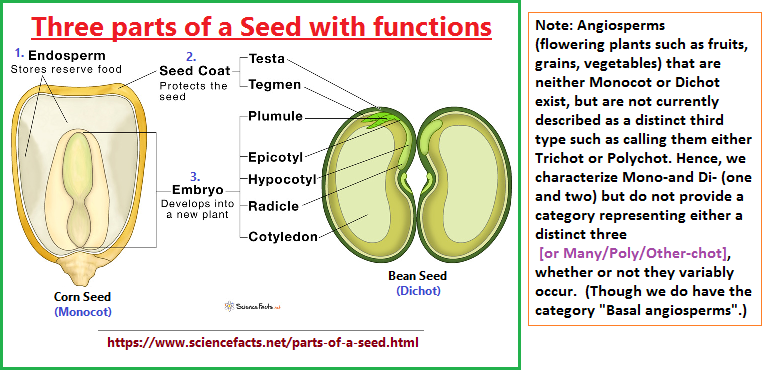
3 parts of a seed:
- Seed coat: (Seed coat forms from the two integuments or outer layers of cells of the ovule.)
- Endosperm (cotyledon)
- Endosperm is derived from two polar nuclei fusing with one sperm, which is a triploid tissue in most species such as cereals.
- Embryo (plumule, radicle, hypocotyl) [Development of a Seed]
Within the angiosperms are three major groups: basal angiosperms, monocots, and dicots. Basal angiosperms are a group of plants that are believed to have branched off before the separation of the monocots and eudicots, because they exhibit traits from both groups. They are categorized separately in most classification schemes. Plant Diversity: Angiosperms
The angiosperms are divided into three species: (Biology on-Line: Angiosperm)
- Hermaphroditic (pistils and stamens are on the same flower)
- Monoecious (stamens and pistils are on the different flower but over the same plant).
- Dioecious (both stamens and pistils are found in different flowers in different plants).
Flowering plants categorized by three divisions according to life cycles: ( Classification of Flowering Plant)
- Perennials: flower for at least two years.
- Biennials: require two growing seasons to complete their life process.
- Annuals: single year cycle.
Flowering plants classified by two divisions of embryonic leaf appearance in seed bearing plants: (Monocots versus Dicots The Two Classes of Flowering Plants)
- Monocot (one embryonic leaf) resulting in plants whose leaves come in multiples of three.
- Dichot (two embryonic leaves) resulting in plants whose leaves come in multiples of four or five.
| MONOCOTS | DICOTS | TRICOTS |
| Embryo with single cotyledon | Embryo with two cotyledons | Embryo with three cotyledons |
| Pollen with single furrow or pore | Pollen with three furrows or pores | Pollen with three furrows or pores? |
| Flower parts in multiples of three | Flower parts in multiples of four or five | Flower parts in multiples of ? |
| Major leaf veins parallel | Major leaf veins reticulated | Major leaf veins ? |
| Stem vacuolar bundles scattered | Stem vascular bundles in a ring | Stem vascular bundles... ? |
| Roots are adventitious | Roots develop from radicle | Roots...? |
| Secondary growth absent | Secondary growth often present | Secondary growth? /Tertiary growth? |
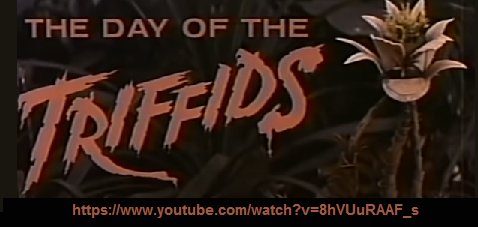
(Note: I recall at least one movie in which plants were described with a "three-linked" moniker: The Day of the Triffids. It should also be pointed out that the introduction of plants in the movie beginning with a reference to the Venus Fly trap, does not include a comment about the three hairs used to detect the presence of a potential meal.)
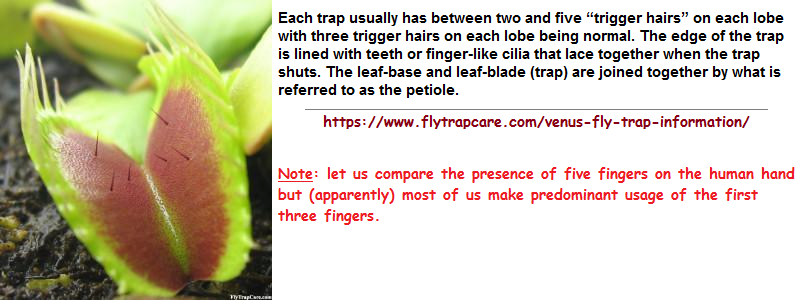
Let me emphasize that in speaking of the two classes of flowering plants, there is controversy over distinctions because examples exist which appear to represent a type of overlap, fusion or even mix and/or matching organization. Is there a Tri-cot class in the making but will not be fully viable until some later age or is there to be a Tricot as a product of three-in-one? Did a Trichot model exist long ago but has degenerated to what we have today due to some unrecognized deterioration in the genetic substratum?
With respect to plants we can also find additional enumerated patterns such as when comparing the three metabolic carbon fixation pathways... of which C3 is most common, though C4 plants offer the advantage of using less water for high temperature environments. About 95% of all green plants are of the C3 variety:
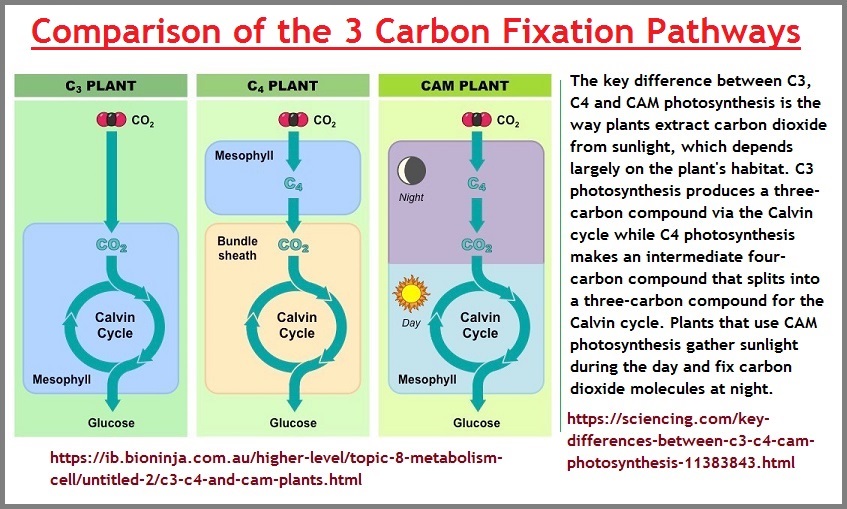
Listed below are some significant differences
| C3 | C4 | CAM | ||
| What it means | ||||
| This pathway is observed in C3 plants wherein the primary product from sunlight post carbon-grasping is 3-phosphoglyceric acid to produce energy | Sunlight is converted into oxaloacetic acid by some plants prior to C3 cycle which is further converted into energy. The plants are known as C4 plants. It is the C4 pathway | Plants store solar energy post which they convert into energy in the night, such plants are CAM plants and the pathway is referred to as CAM pathway | ||
| Cells included | ||||
| Mesophyll cells | Bundle sheath cells, Mesophyll cells | Mesophyll cells in C3 and C4, both | ||
| Observed in | ||||
| All plants carrying out photosynthesis | Tropical plants | Semi-dry climatic conditions | ||
| Plant types that use this cycle | ||||
| Hydrophytic, Mesophytic, Xerophytic plants | Mesophytic plants | Xerophytic plants | ||
| Photorespiration process | ||||
| Observed in higher rates | Not seen as much | Observed in the noon time | ||
| First-stable product produced | ||||
| 3-phosphoglycerate | Oxaloacetate | Daytime – 3-phosphoglycerate
Night time – Oxaloacetate |
||
| Number of molecules of NADPH and ATP required to produce glucose | ||||
| NADPH – 12
ATP – 18 |
NADPH – 12
ATP – 30 |
NADPH – 12
ATP – 39 |
||
| The ideal photosynthetic temperature | ||||
| 15-25 degree Celsius | 30-40 degree Celsius | Greater than 40-degree Celsius | ||
| Calvin cycle functional | ||||
| Not accompanied with any other cycle | Accompanied along with C4 pathway | C4 pathway and C3 | ||
| Example | ||||
| Beans, Spinach, Sunflower, Rice, Cotton | Maize, Sorghum, Sugarcane | Orchids, Cacti, euphorbias | ||
| Carboxylating enzyme | ||||
| In C3, RuBP carboxylase | PEP carboxylase – mesophyll
RuBP carboxylase – bundle sheath |
RuBP carboxylase – day time
PEP carboxylase – night time |
||
| Ratio – Co2:ATP: NADPH2 | ||||
| The ratio is 1:3:2 | The ratio is 1:5:2 | The ratio is 1:6:5:2 | ||
| >Kranz Anatomy | ||||
| Not present | Present | Not present | ||
| Initial CO2 receptor | ||||
| Ribulose-1, 5-biphosphate | Phosphoenolpyruvate | Phosphoenolpyruvate | ||
| Carbon dioxide compensation point (In PPM) [parts per million] | ||||
| Thirty to seventy | six to ten | In dark: 0-5 | ||
Source for table: Difference Between C3, C4 and CAM pathway
We have a pattern-of-three organization when it comes to providing a differentiation of chromosomal account activity. We call the first Haploid, the second Diploid, and a three or more situation as a polyploid... signifying three or more chromosome pairings. The "three" becomes a point of demarcation in our minds just as we separate ones-tens-hundreds by a comma, before going on to the three-segmented thousands division in our place-value system of enumeration. In the next image is not only a basic one-two-many profile of categorization in males, but a comparison of this pattern with that found in females which exhibit a three-to-one ratio. Other three-to-one ratios can be seen here: Three-to-One ratios page A.
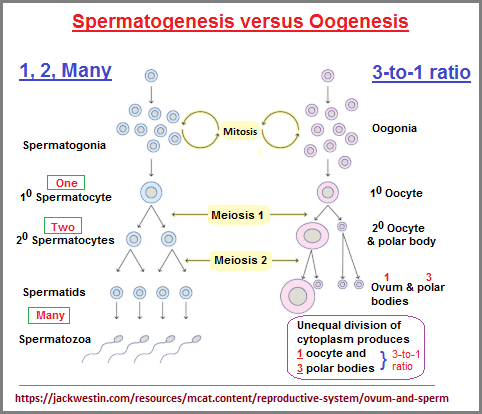
Using numbers as references is part of the human cognitive domain of tools. If put on a graph, we would find that recurring numbers can constitute a pattern of thinking... or at least thinking about a particular subject's information in a given way. For example, if someone asks a given sample of people what their favorite number is, we must look at in which context and which culture the sampling of people provided the response. For example, in this Nautilus article: Found: The World's Favorite Number by Dana Mackenizie, March 28,2017, in which she describes a question posed by Alex Bellos (a mathematic's blogger working for the Guardian) as to which is his readers' favorite number. The first was 7, the next was 8 and the third was number 3. That is, from an apparent 44,000+ respondents. Of course many of us could well point out flaws and one in particular is to ask the question in a group that may well want to intentionally describe some odd-ball figure like some class clown or calls rebel blurting out some comment to either appear comical or as some sort of supposed unrecognized genius who as a believed-in right to be different than others.
However, let us put the same people into a context where number patterns are discussed in relation to the recurring number patterns found in different subjects, and you might well see not just a few either changing their mind about a given number they actually recognize as one which appears to crop up frequently in their perceptions, or those established during a given moment in a knee-jerk like response. When we find that many people may not even consider having a favorite number, and instead encounter one or more numbers more frequently than others when they are in a particularly number-sensitive mood of observation, our concept concerning the question of what is a person's favorite number takes on a different dimension of definition. Some people may not have a favorite number but simply join in the like many a kid who simply steps in to participate in a game and select that which may appear to be an adequate selection for appealing to others that they too belong with a given group. A psychology of "favorite number" is just as superficially attended to as those accounts of cultural number patterns provided by cultural anthropologists. Much like Mathematicians and Linguists who not only do not ask the appropriate questions, they do not know how to look below the surface of their own subject's surface material to see the recurring cognitive patterns being aligned in accordance with the structure of grammar they are using. They mistakenly think that labels such as surface and deep structure suffice to provide generalized specifics yet overlook that they are using a dichotomy in the process. In other words, very frequently, they singularly isolate by way of dichotomies, and then trichotomize the results... where the third item in their equation can take on some multiplicity referencing some third positioned "Many".
Date of (series) Origination: Saturday, 14th March 2020... 6:11 AM
Date of Initial Posting (this page): Saturday, 6th August 2022... 1:40 PM